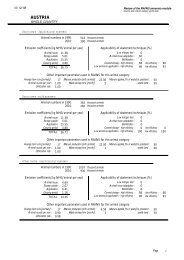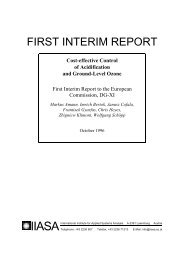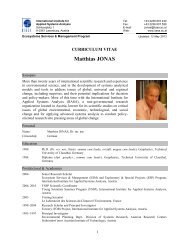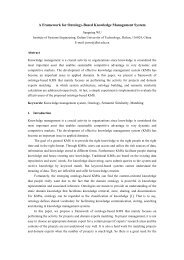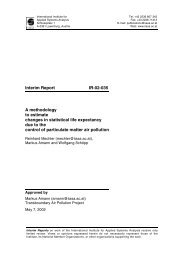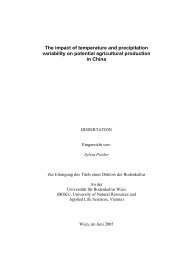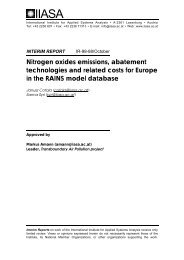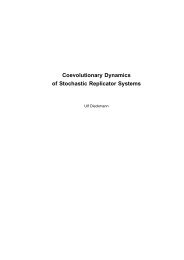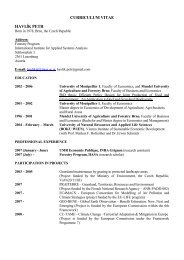presentation - IIASA
presentation - IIASA
presentation - IIASA
You also want an ePaper? Increase the reach of your titles
YUMPU automatically turns print PDFs into web optimized ePapers that Google loves.
NEXT GENERATION<br />
MODEL MANAGEMENT<br />
AND INTEGRATION<br />
Prof. Daniel Dolk<br />
CSM Workshop<br />
August 2006
OVERVIEW<br />
“It is possible to view every process that occurs in nature or elsewhere as a computation”<br />
– Stephen Wolfram<br />
“Information is static…computation computation is dynamic” – Rudy Rucker<br />
• Retrospective of model management<br />
• Elements of NGMMI<br />
• Emergence of computational modeling and<br />
computational experimentation in scientific<br />
inquiry<br />
• Virtual environments in the form of Society of<br />
Simulations
SCIENTIFIC METHOD,<br />
15 TH -20 TH CENTURIES<br />
Theory<br />
Design<br />
Analysis and<br />
Explanation<br />
Experiment
SCIENTIFIC METHOD,<br />
1950 - PRESENT<br />
Analysis &<br />
Explanation<br />
Modeling &<br />
Simulation<br />
Analysis<br />
Design<br />
Design<br />
Theory<br />
Design<br />
Validation<br />
Experiment
MODEL MANAGEMENT REDUX<br />
• “The process of representing, solving, analyzing and<br />
integrating analytical models (primarily in the<br />
information and management sciences (OR/MS)) in<br />
computer executable form” -- Dolk<br />
• Initially conceived as a modeling counterpart to data<br />
management<br />
– Models as a corporate resource<br />
– Models, like data, need to be systematically managed<br />
– Rich vein of OR/MS-based models and solvers<br />
– Model management system<br />
• Part of the troika of DSS<br />
– Data, models, dialogue (later, knowledge)<br />
– Models as the lynchpin for decision-making (Simon et al)
MODEL MANAGEMENT REDUX:<br />
MODEL MANAGEMENT SYSTEM<br />
“If DBMS, why not MMS?”<br />
Desirable Requirements/Features of an MMS:<br />
• Support entire modeling life cycle<br />
• Uniform re<strong>presentation</strong> of models<br />
• Modeling languages<br />
• Portfolio of cross-paradigm OR/MS models<br />
• Library of solvers<br />
• Model integration<br />
• Separation of models and data<br />
• Separation of models and solvers<br />
• Leverage RDBMS for data manipulation<br />
Central issue: Model Re<strong>presentation</strong>
MODEL MANAGEMENT REDUX:<br />
MODEL REPRESENTATION<br />
Theoretical driver: Is there a way to represent<br />
models that is comparable in power to the<br />
relational theory re<strong>presentation</strong> of data?<br />
• Relational (Blanning)<br />
• Object-oriented (Dolk)<br />
• Structured modeling (Geoffrion)<br />
• Logic modeling (Bhargava, Kimbrough)<br />
• Graph grammars (C. Jones)<br />
• Metagraphs (Blanning, Basu)
FEEDMIX MODEL<br />
SM GENUS GRAPH<br />
NUTR<br />
MATERIAL<br />
NUTR_<br />
MIN<br />
MATERIAL<br />
Q<br />
UCOST<br />
ANALYSIS<br />
TOTCOST<br />
T:NLEVEL<br />
NLEVEL
SM ELEMENTAL DETAIL TABLES<br />
FOR FEEDMIX MODEL
STRUCTURED MODELING<br />
• Contributions<br />
CONTRIBUTIONS<br />
– Formal semantic ontology for models<br />
– Math models as conceptual models<br />
– Full language (SML) and implementation<br />
(FW/SM)<br />
– Model reuse and integration<br />
– Multiple modes of model re<strong>presentation</strong>
LIMITATIONS OF<br />
STRUCTURED MODELING<br />
“Why isn’t t structured modeling (or equivalent) used as a matter of course in<br />
OR/MS modeling endeavors?”<br />
• Endogenous factors:<br />
– No graph-driven implementation<br />
– Static vs. dynamic re<strong>presentation</strong>s<br />
– Complexity of indexing semantics<br />
• Exogenous factors:<br />
– Math as legal tender: OR analysts are overwhelmingly mathematicians<br />
– Overhead of conceptual modeling: Even database analysts resist conceptual c<br />
modeling<br />
– Models don’t t command the same respect as data<br />
– UML has become the lingua franca of conceptual modeling<br />
– Internet and distributed computing<br />
• (“It can be done” & “It should be done”) ) ~=> (“It(<br />
will be done”)
CONTRIBUTIONS OF 1 ST<br />
GENERATION MODEL<br />
MANAGEMENT<br />
• Decoupling of models, solvers and data<br />
– “run-time” binding of data and solver to model re<strong>presentation</strong><br />
• Model re<strong>presentation</strong> formalisms<br />
– Structured modeling (Geoffrion(<br />
Geoffrion); meta-modeling modeling (Blanning(<br />
and<br />
Basu); graph grammars (Jones); logic modeling (Bhargava and<br />
Kimbrough); object-oriented oriented (Dolk(<br />
Dolk)<br />
– Modeling languages (AMPL: Fourer and Gay)<br />
• Model integration<br />
– Dimensional analysis (Bradley and Clemence)<br />
– Semantic consistency (Bhargava and Kimbrough)<br />
– Relational data systems for managing data<br />
– Model composition (Dolk(<br />
and Kottemann; Geoffrion)
LIMITATIONS OF 1 st<br />
GENERATION MODEL<br />
MANAGEMENT<br />
• Decision-makers are, on average, “model averse”<br />
• Never really a market for the MMS<br />
– Cross-paradigm myopia in the OR/MS community<br />
– “The spreadsheet is the MMS”<br />
– Result: a fully functional MMS was never implemented<br />
• Data more important than models<br />
• No comprehensive, integrating theory (as in relational<br />
data world)<br />
• Internet shifted attention from static re<strong>presentation</strong>s to<br />
dynamic, distributed resources
MODEL MANAGEMENT AND<br />
THE INTERNET<br />
• Internet shifted the focus on many different<br />
levels:<br />
– from stand-alone alone machine centric (static) to<br />
distributed network-centric (dynamic)<br />
– from top down to bottom up<br />
– from MMS as single monolithic system to MMS as<br />
dynamic, configurable S/W components<br />
– from S/W as commodity to S/W as service<br />
– from individual problem solving to collaborative<br />
problem solving<br />
• AME
ELEMENTS OF<br />
NEXT GENERATION<br />
MODEL MANAGEMENT<br />
There is still a need for model management, but this seems to go<br />
largely unrecognized.<br />
• Model management as an exemplar of knowledge management rather than t<br />
an<br />
extension of data management<br />
– Models recast in the context of Knowledge and Knowledge Flow enablers, , or<br />
– Models in the context of the Pentagram Creative Space (Involvement, nt, Imagination,<br />
Intervention, Integration, Intelligence) (Nakamori(<br />
Nakamori)<br />
– “Model dynamics” (?) rather than “model management”<br />
– Decision as a process ( (decision decision supply chain) rather than a point estimate<br />
– Collaborative decision-making vs. individual decision-making<br />
• Shift from analytical modeling to computational modeling and virtual environments<br />
– Concept of complexity has changed radically<br />
– Evolutionary biology has replaced physics as the scientific paradigm of interest in the social<br />
sciences<br />
– Ascendancy of network “science” and agent technology<br />
– Model integration in one form as a Society of Simulations
KNOWLEDGE FLOWS IN<br />
THE MODELING LIFECYCLE<br />
Model Versioning<br />
And Security<br />
Problem<br />
Identification<br />
Model<br />
Formulation<br />
Model<br />
Maintenance<br />
Model<br />
Implementation<br />
Model<br />
Validation<br />
Model<br />
Solution<br />
Model<br />
Interpretation
COMPUTATIONAL SCIENCE<br />
• Computational science involves using computers to study scientific ic problems and<br />
complements the areas of theory and experimentation in traditional al scientific<br />
investigation.<br />
• Computational science seeks to gain understanding of science principally through the<br />
use and analysis of computational models, often on high performance computers.<br />
• Computational modeling and simulation is being accepted as a third methodology in<br />
engineering and scientific research that fills a gap between physical experiments and<br />
analytical approaches.<br />
• Experiments traditionally performed in a laboratory, wind tunnel, , or the field are<br />
being augmented or replaced by computational experimentation (simulations).<br />
• These simulations provide both qualitative and quantitative insights into many<br />
phenomena that are too complex to be dealt with by analytical methods (e.g.,<br />
organizational dynamics) or too expensive or dangerous to study by experiments<br />
(e.g., bioterrorist attacks, nuclear repository integrity).
ASPECTS OF<br />
COMPUTATIONAL MODELING<br />
• Procedural as separate from equational or axiomatic<br />
– E.g., cellular automata, Monte Carlo simulations for solving systems of<br />
PDEs numerically<br />
• Constructivist, or very nearly so, in nature<br />
– “if you can’t t build it, you don’t t understand it” (Langton)<br />
– Artifact-building vs. theory-building<br />
• Emergent behavior vs. hierarchical decomposition & recomposition<br />
• Types of models<br />
– “what is”; ; descriptive (ex: discrete event simulation)<br />
– “what should be”; ; prescriptive (ex: optimization)<br />
– “what will be”; ; predictive (ex: econometric forecasting)<br />
– “what could be”; ; constructive (ex: artificial life)
EXAMPLES OF COMPUTATIONAL<br />
MODELING FOR SOME REFERENCE<br />
DISCIPLINES<br />
• Biology: DNA and the genome; artificial life<br />
[Keller 2002]<br />
• Physics: numerical analysis of systems of<br />
PDEs<br />
• Mathematics: Mathematica [Wolfram 2002]<br />
• Finance: options pricing
COMPUTATIONAL MODELING in the<br />
INFORMATION and SOCIAL<br />
SCIENCES<br />
• Computational models of human behavior<br />
– How do we construct agents?<br />
– Computational models of cognition [Edelman 1987]<br />
– Experimental economics<br />
– Economic decision-making under uncertainty (Tversky(<br />
&<br />
Kahneman)<br />
• Organization science: Computational organizations<br />
[Prietula<br />
& Carley 1994; Levitt 2004]<br />
• Economics: evolutionary economics [Nelson and Winter<br />
2002]; synthetic economies [Epstein & Axtell 1996];<br />
• Network “science”:: [Barabasi[<br />
2002]; social network<br />
analysis [Wassermann 1994]
COMPUTATIONAL<br />
EXPERIMENTATION<br />
• Computational experimentation as an alternative or augmentation to analytical /<br />
laboratory and field experimentation<br />
from [Nissen and Buettner 2004]
Computational<br />
Modeling<br />
Virtual Environments linked<br />
via Network interfaces with<br />
shared semantics<br />
Design<br />
Analysis<br />
Hypothesis<br />
Generation<br />
Computational<br />
Experimentation<br />
Analysis<br />
Design<br />
Design<br />
Theory<br />
Design<br />
Analysis, Confirmation/Refutation<br />
Experiment<br />
-Live: Laboratory<br />
and Field<br />
COMPUTATIONAL MODELING AND VIRTUAL<br />
ENVIRONMENTS
MODEL DYNAMICS AND<br />
VIRTUAL ENVIRONMENTS<br />
• LEAD (Linked Environments for Atmospheric Discovery)<br />
– Collaboration among meteorologists, computer scientists,<br />
educational experts<br />
– Objective:<br />
• Respond to weather phenomena in real time<br />
• Execute multi-model model simulations of weather forecasts distributed on<br />
the Grid<br />
• Adapt computing resources dynamically<br />
– Services:<br />
• Workflow system: dynamic control of experiments<br />
• Metadata catalog for managing experimental results<br />
• Notification system as a communications layer
SOCIETY of SIMULATIONS<br />
APPROACH TO LINKING<br />
VIRTUAL ENVIRONMENTS<br />
• Problem: How do you link local virtual environments<br />
(models) developed with local semantics into a global<br />
virtual environment (integrated model) with a common<br />
semantics? (This is the problem of the Semantic web;<br />
also, to a large degree, the aggregation problem)<br />
• A Society of Simulations is analogous to a society of<br />
people, as both are loosely coupled constructs in which<br />
independent individuals contribute toward a single<br />
societal identity. A society is an organized group of<br />
individuals who associate for common purposes.<br />
• Likewise, autonomous simulations in a Society of<br />
Simulations work together to achieve the common goal<br />
of modeling the system.
SOCIETY of SIMULATIONS<br />
COMPONENTS<br />
• Members: Stand-alone alone simulations or models<br />
(ABS, DES, SD, OR/MS, etc), built specifically for<br />
a Society, other components such as<br />
visualizations and user interfaces<br />
• Shared Reality: stores the shared aspects of a<br />
Member’s model(s)<br />
• Liaisons: links Members with Shared Reality
MORE ELEMENTS OF<br />
NEXT GENERATION<br />
MODEL MANAGEMENT<br />
• Solver environments<br />
– Combining information systems and model development techniques<br />
– Meta-heuristic environments<br />
– Grid computing<br />
– Network science<br />
• Data (structured + semi- / unstructured)<br />
– Search engine technology<br />
– Advanced data/text/image mining<br />
– Semantic Web<br />
– Dynamically configurable and executable models a la Google type interfaces<br />
• Application areas<br />
– Supply chain management<br />
– Services science (?), management and engineering: Web services, service-<br />
oriented architecture as IME<br />
– Computational economies, societies, organizations<br />
– Network science (social network analysis)
APPLICATION AREA:<br />
SEMANTIC WEB<br />
• The Semantic Web is a web of data. There is lots of data we all use every<br />
day, and its not part of the web. I can see my bank statements on the web,<br />
and my photographs, and I can see my appointments in a calendar. But<br />
can I see my photos in a calendar to see what I was doing when I took<br />
them? Can I see bank statement lines in a calendar?<br />
• Why not? Because we don't have a web of data. Because data is controlled<br />
by applications, and each application keeps it to itself.<br />
• The Semantic Web is about two things. It is about common formats for<br />
interchange of data, where on the original Web we only had interchange of<br />
documents. Also it is about language for recording how the data relates to<br />
real world objects. That allows a person, or a machine, to start off in one<br />
database, and then move through an unending set of databases which are<br />
connected not by wires but by being about the same thing.<br />
( http://www.w3.org/2001/sw/ )<br />
( http://www.scientificamerican.com/article.cfm?articleID=00048144-<br />
10D2-1C70<br />
1C70-84A9809EC588EF21&pageNumber=1&catID=2<br />
)<br />
• Model Dynamics counterpart: Composing services to satisfy a user r request<br />
is the same problem as composing models to solve a particular application.<br />
plication.<br />
• Research areas: Ontologies, , semantic resolution, dimensional consistency,<br />
logical vs physical integration
APPLICATION AREA:<br />
SERVICES MANAGEMENT<br />
AND ENGINEERING<br />
• “Services sciences, Management and Engineering<br />
hopes to bring together ongoing work in computer<br />
science, operations research, industrial<br />
engineering, business strategy, management<br />
sciences, social and cognitive sciences, and legal<br />
sciences to develop the skills required in a services-<br />
led economy.”<br />
http://www.research.ibm.com/ssme/
APPLICATION AREA:<br />
SERVICES MANAGEMENT<br />
AND ENGINEERING<br />
• “The science comes in through modeling. You model kernels of a<br />
work practice to gain insight and for the purposes of automation”<br />
Richard Newton, Dean of the College of Engineering at the<br />
University of California, Berkeley.<br />
• Modeling, simulation, abstraction, measurement and metrics, and<br />
process design and analysis will emerge as core disciplines of<br />
science-based services<br />
• Equipped with the right tools (e.g. dynamically reconfigurable<br />
architectures for “on demand” computing), nonprogrammers will<br />
be able to design, model, and simulate business processes.
SOME RESEARCH AREAS<br />
FOR NGMMI<br />
• Computational models of human behavior<br />
– Experimental economics, cognitive science, psychology, decision science<br />
– Agent re<strong>presentation</strong>s<br />
• Ontologies<br />
– Model assumptions, structural re<strong>presentation</strong>s, dynamic re<strong>presentation</strong>s, agent<br />
behavior<br />
• Model integration<br />
– How to integrate inter-paradigm models such as ABS, DES, Optimization,<br />
Forecasting, Soft vs. Crisp, Quantitative vs. Qualitative, etc., etc. models? How<br />
do you represent these models and how do you merge them semantically? ally? (Ex:<br />
artificial labor market)<br />
– How to integrate intra-paradigm models? E.g., how do you integrate an ABS<br />
whose agents are people with an ABS whose agents are strategies?<br />
– Ontology integration (meta-ontology)<br />
• Model validation, esp. for emergent (“what(<br />
could be”) ) models<br />
– What is (are) the role(s) ) of “what could be” models in scientific inquiry?<br />
• Measurement of knowledge flows resulting from analytical/computational tional models<br />
– How useful are models, really?<br />
– “Good” vs. “Bad” models and their effects upon the Knowledge Base
Backup Slides
SOME REFERENCES<br />
• COMPUTATIONAL EXPERIMENTATION<br />
– Nissen, M. and Buettner, R. Computational experimentation with the t<br />
Virtual Design<br />
Team: Bridging the chasm between laboratory and field research in C2. " Proceedings<br />
Command and Control Research and Technology Symposium, , San Diego, CA, 2004.<br />
– Kevrekidis, , I. Equation-Free Modeling for Complex Systems. Frontiers of Engineering:<br />
Reports on Leading-Edge Engineering from the 2004 NAE Symposium on Frontiers of<br />
Engineering, 69-76.<br />
• COMPUTATIONAL EXPLANATION<br />
– Keller, E.F. Making Sense of Life: Explaining Biological Development with Models,<br />
Metaphors, and Machines. Harvard University Press, Cambridge, MA, 2002.<br />
– Kimbrough, S. Computational Modeling and Explanation: Opportunities ies for the<br />
Information and Management Sciences. Computational Modeling and Problem Solving in<br />
the Networked World, , Hemant K. Bhargava and Nong Ye, eds., Kluwer, , Boston, MA, 31-<br />
57, 2003.<br />
• COMPUTATIONAL ORGANIZATIONS<br />
– Carley, , K. M. & Prietula, , M. J. (Eds.), 1994, Computational Organization Theory,<br />
Hillsdale, NJ: Lawrence Erlbaum Associates.<br />
– Levitt, , R. E., (2004). Computational Modeling of Organizations Comes of Age. Journal of<br />
Computational & Mathematical Organization Theory, 10(2); 127-145, 145, July 2004.
REFERENCES (cont’d)<br />
• EVOLUTIONARY ECONOMICS AND SYNTHETIC ECONOMIES<br />
– Chaturvedi, A., Mehta, S., Dolk, D., Ayer, R. Agent-based simulation for<br />
computational experimentation: developing an artificial labor market.<br />
European<br />
Journal of Operations Research 166:3, 694-716, 2005.<br />
– Epstein, J. and Axtell, R. Growing Artificial Societies: Social Science from the<br />
Bottom Up. . The Brookings Institution and the MIT Press, Washington D.C. and<br />
Cambridge, MA, 1996.<br />
– Nelson, R. and Winter, S. An Evolutionary Theory of Economic Change. The<br />
Belknap Press of Harvard University Press, Cambridge MA, 1982.<br />
• MODEL MANAGEMENT<br />
– Basu, , A. and Blanning, , R. Model integration using metagraphs. Information<br />
Systems Research, 5:3; 195-218, 1994.<br />
– Bhargava, H. and Kimbrough, S. Model management: An embedded languages<br />
approach. Decision Support Systems, 10; 277-299, 299, 1993.<br />
– Dolk, D. Model integration in the data warehouse era. European Journal of<br />
Operational Research, April 2000.<br />
– Geoffrion, , A.M. An introduction to structured modeling. Management Science,<br />
33: 5, 547-588, 588, May 1987.<br />
– Jones, C. An introduction to graph based modeling systems, Part I: Overview.<br />
ORSA Journal on Computing, , 136-151, 151, 1990.
REFERENCES (cont’d)<br />
• NETWORK SCIENCE<br />
– Barabasi, , A-L. A<br />
Linked: How Everything is Connected to Everything Else and What<br />
It Means for Business, Science, and Everyday Life. Plume Press, 2003.<br />
– J.C. Doyle, D. Alderson, L. Li, S. Low, M. Roughan, , S. Shalunov, , R. Tanaka, and W.<br />
Willinger. . The "robust yet fragile" nature of the Internet. Proc. Nat. Acad. Sci.<br />
USA. October 4, 2005.<br />
• SOCIAL NETWORK ANALYSIS<br />
– Wasserman, S. and Faust, K. (1994) Social Network Analysis: Methods and<br />
Applications. . Cambridge: Cambridge University Press.<br />
– Krackhardt, , K. and Hanson, J. Informal networks: The company behind the<br />
chart. Harvard Business Review, 103-111, 111, July-August, 1993.<br />
• KNOWLEDGE MANAGEMENT AND DYNAMICS<br />
– Wierzbicki, A. and Nakamori, , Y. (2006) Creative Space: Models of Creative<br />
Processes for the Knowledge Civilization Age. Springer Press.<br />
– Nissen, M. (2006) Harnessing Knowledge Dynamics: Principled Organizational<br />
Knowing. IRM Press.
SOCIETY of SIMULATIONS:<br />
MEMBER COMPONENT<br />
• Each simulation, or model, in a Society is an<br />
autonomously managed Member which<br />
cooperates with other Members to reach its<br />
personal goals.<br />
• In the process of meeting its personal goals, a<br />
Member contributes to societal goals.<br />
• Satisfaction of societal goals emerges as all<br />
Members progress towards their personal goals.
SOCIETY of SIMULATIONS:<br />
MEMBER COMPONENT<br />
• Members:<br />
– Inputs/Outputs:<br />
• Syntax: data structure and type<br />
• Granularity: spatial and temporal (can differ widely across different<br />
simulations<br />
• Semantics: the meaning of an input/output (e.g., A door in a building layout<br />
means a wooden obstacle to a FireSim and a removable blockage on an exit<br />
route to a HumanSim)
SOCIETY of SIMULATIONS:<br />
SHARED REALITY<br />
• Shared Reality:<br />
– Shared aspects of a Member’s s models<br />
– Does not manage how the Members operate<br />
– Persistent information space<br />
– The intelligence for transforming information within Shared Reality into<br />
a form a consumer can digest and for synchronizing a consumer with<br />
produced data is pushed from the data exchange mechanism of Shared<br />
Reality onto the linkages (Liaisons) that connect the Members to Shared<br />
Reality.<br />
– Shared Reality is lightweight, in the sense that overheads increase less<br />
than linearly as the number of Members or the amount of data being<br />
exchanged increases.<br />
– Decouples the producers and consumers of data<br />
• Member’s s design is separated from the data exchange mechanism.<br />
• Extensions to a Member’s s design do not require changes to the design of<br />
Shared Reality.
SOCIETY of SIMULATIONS<br />
APPROACH<br />
• Liaisons:<br />
– Each Member in a Society accesses Shared Reality through a Member-<br />
specific Liaison<br />
– Liaison consists of the intelligence needed to interact with and control a<br />
Member and to interact with the rest of the Society.<br />
– Liaison is configured to use Member-specific mechanisms—<br />
initializations, inputs, outputs, and control mechanisms.<br />
– Same Member can be used in different Societies and be continuously<br />
developed without being forced to address Society-specific<br />
characteristics, enabling reuse and distributed development.<br />
– Liaison Tasks:<br />
• Synchronizes the Member with data the Member depends on<br />
• Starts, stops, restarts, and checkpoints a Member.<br />
• Gathers data from Shared Reality, transforms its syntax, converts s its<br />
granularity, and translates its semantics.<br />
• Places the Member’s s outputs into Shared Reality coupled with semantic<br />
information describing the syntax, granularity, and semantics of the data.
EXAMPLE: EVACUATION<br />
SOCIETY
BENEFITS of SoS APPROACH<br />
• Enables distributed development<br />
• Heterogeneity is supported by allowing independent development of o<br />
Member designs<br />
• Autonomous management is enabled by linking Members to<br />
information instead of to other Members<br />
• Avoids publisher-subscriber subscriber dependence<br />
• Society of Simulations approach allows simulations to cooperate, yet<br />
remain autonomous, an inherently modular and scalable approach<br />
for linking heterogeneous simulations.<br />
• Example: Urban Resolve 2015 (15 simulations, 6 of which use SoS;<br />
2000 players; 2 weeks duration)<br />
• SoS works primarily at the syntactic level; Next step: extend to the t<br />
semantic level (Semantic Web)
STRUCTURED MODELING and<br />
the 21 st CENTURY<br />
• UML, ERD still do not support decision models<br />
and OR/MS applications<br />
• OLAP Extension: SM and OLAP<br />
• Model Standardization: SM and XML<br />
• SM and Ontology<br />
• SM and KM: Wikipedia counterpart for models<br />
• Dynamic SM<br />
• SM and Computational Modeling: opportunities<br />
in the life sciences?



